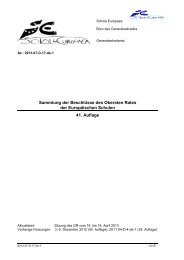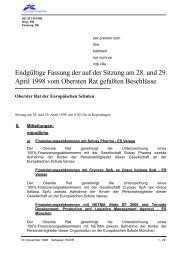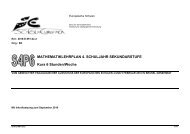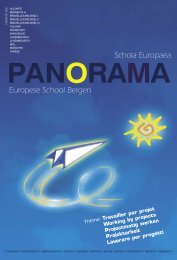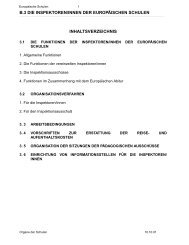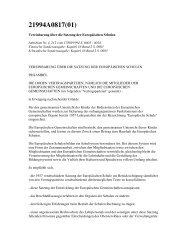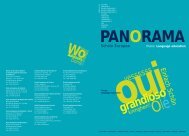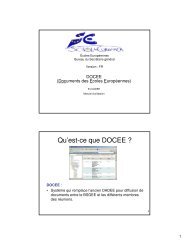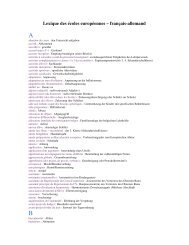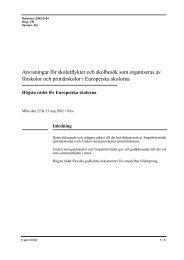External Evaluation of the European Baccalaureate (Annexes)
External Evaluation of the European Baccalaureate (Annexes)
External Evaluation of the European Baccalaureate (Annexes)
You also want an ePaper? Increase the reach of your titles
YUMPU automatically turns print PDFs into web optimized ePapers that Google loves.
chosen at AS. Two Mechanics options and two Discrete Maths options are only covered by GCE, no<br />
elements <strong>of</strong> <strong>the</strong>se option modules feature in <strong>the</strong> EB. There is some overlap to a similar level <strong>of</strong> difficulty in<br />
<strong>the</strong> Probability and Statistics options and <strong>the</strong> Fur<strong>the</strong>r Pure options.<br />
The syllabus would appear to reflect <strong>the</strong> different priorities in <strong>the</strong> Maths education to age 16. The EB<br />
shows a greater emphasis on Functions, Probability and Analytical Geometry. The GCE places a greater<br />
priority on Algebra across <strong>the</strong> Core curriculum. Trigonometry has a high priority at GCE and <strong>the</strong> GCE<br />
focuses on Number through <strong>the</strong> teaching <strong>of</strong> Sequences and Series and iterative processes, unlike <strong>the</strong> EB,<br />
which does not assess <strong>the</strong> learning in <strong>the</strong>se areas.<br />
Where <strong>the</strong>re is an overlap in <strong>the</strong> syllabus content, ei<strong>the</strong>r one Board or <strong>the</strong> o<strong>the</strong>r will take <strong>the</strong> subject to a<br />
greater level <strong>of</strong> difficulty. The EB has a greater focus on Functions. The level <strong>of</strong> difficulty is higher than<br />
that <strong>of</strong> <strong>the</strong> GCE, which over two years only just matches <strong>the</strong> year 6 course content <strong>of</strong> <strong>the</strong> EB. The GCE<br />
has a greater degree <strong>of</strong> difficulty when comparing <strong>the</strong> Differentiation element <strong>of</strong> <strong>the</strong> course.<br />
There is no obvious evidence on links between topics in <strong>the</strong> exam papers. With both papers using short-<br />
response questions, this will be difficult to achieve. The EB diploma has one question from each <strong>of</strong> <strong>the</strong><br />
strands - algebra, complex numbers, analysis, geometry, probability and numerical analysis <strong>of</strong> data. Then<br />
optional questions again form each strand. The GCE does not place order on <strong>the</strong> questions and does not<br />
appear to write exams with only one question on each aspect <strong>of</strong> <strong>the</strong> syllabus for that particular module.<br />
ASSESSMENT<br />
OCR GCE<br />
Each module is assessed by a 1 hour 30 minute exam; each module is equally weighted at 33⅓%. Three<br />
modules, C1, C2 and an option make up <strong>the</strong> AS level and C3, C4 and an option make up <strong>the</strong> A2 section.<br />
The exams are marked by external examiners and a sample <strong>of</strong> <strong>the</strong> scripts is marked by a second<br />
examiner to ensure consistency and accuracy.<br />
The exams are a series <strong>of</strong> short-response questions, <strong>the</strong>re are no optional questions. Each paper is given<br />
a raw score out <strong>of</strong> 72. It is up to <strong>the</strong> teacher and student as to whe<strong>the</strong>r <strong>the</strong>y sit <strong>the</strong> module exam in<br />
January or June, giving additional flexibility along with <strong>the</strong> choice <strong>of</strong> option to study. The course can be<br />
tailored to <strong>the</strong> individual needs <strong>of</strong> <strong>the</strong> student<br />
EB<br />
Written Exams<br />
For <strong>the</strong> <strong>European</strong> <strong>Baccalaureate</strong>, students will take a written examination ( 4 hours) consisting <strong>of</strong> four<br />
short compulsory questions( 50 marks in total) two questions on analysis, one on geometry and one on<br />
probability. Then two optional long questions, from a choice <strong>of</strong> three questions- one on analysis, one on<br />
geometry and one on probability. Questions will be based mainly on <strong>the</strong> year 7 syllabus, but may require<br />
knowledge <strong>of</strong> material studied in year 6. Marking takes into account method and interestingly presentation.<br />
A formula booklet is provided to support in <strong>the</strong> exams. Exams will take 3 or 4 hours.<br />
Total marks available 36 out <strong>of</strong> 100<br />
Class work<br />
A marks<br />
Class marks are also given in <strong>the</strong> 7 th year (no mention <strong>of</strong> 6 th year) it will be given as an average <strong>of</strong> two<br />
marks<br />
given as Teacher Assessment. This is a summative assessment and could be based on oral participation,<br />
written class work and or practical work. The assessment is done on work in class.<br />
Total marks available 15 out <strong>of</strong> 40 marks<br />
B marks<br />
58



